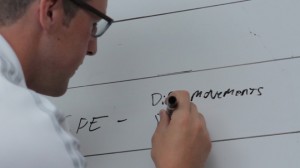In this special episode of 8WeeksOut TV, guest Martin Bingisser joins us to share his insight into the training principles of one of the best coaches in the history of sports, Dr. Anatoliy Bondarchuk. Never has a coach been more dominant in a single sport than Bondarchuk, watch the video to find out why.
The Transfer of Training & Exercise Classification
Dr. Anatoliy Bondarchuk has made many contributions to training methodology, but one of the most important is his concept of “transfer of training.” The idea is simple: train with exercises where an increase in results will transfer to better results in your sport.
All coaches aim to do this, but the difference is whether their decisions are based on anecdote, intuition, or science. Bondarchuk studied thousands of athletes to determine what exercises had the best correlation to high performance in track and field and the results were often surprising.
His findings were specific to track and field, but his methods can be easily applied to other sports.
In order to incorporate transfer of training into a program, it is helpful to first categorize each exercise. Bondarchuk has developed a system that places each exercise into one of four categories depending on various characteristics:
General Preparatory Exercises. These exercises use both energy systems and movements different from the athlete’s competitive event.
Specific Preparatory Exercises. This category of exercises is closer to the competitive event in that they use the same muscles and systems, but in the form of a different movement.
Specific Developmental Exercises. This group, often referred to as “specific strength” or “special strength”, combines the same muscles and systems as the competitive event, as well as parts of the competition movements
Competitive Exercise. The name of this category is self- explanatory. This group includes the competitive event and slight variations.
There are a few important things to note with this system. First, the classification of an exercise is entirely dependent on what event the athlete is training for. What might be considered a specific development exercise for a linebacker could be a specific preparatory exercise for a baseball player or even a general preparatory exercise for a marathon runner.
Second, the categories get progressively more event specific as they move from the general preparatory exercises to competitive exercises. As this happens, the number of exercises to choose from in each category decreases.
Finally, as training becomes more specific, they also allow for the simultaneous development both of the technique and the body to meet the demands of the event. Specific and general preparatory exercises, on the other hand, prepare the body to meet the demands of training and contain no technical element.
About Martin Bingisser


What a coincidence! Great Timing! I’m The strength coach for China’s Olympic Short Track Speed Skating team, and we are actually training in Kamloops BC for the month, The home of Bonarchuk and Canada’s throwing Center. Haven’t had the pleasure in meeting him yet, but I have gotten the chance to talk w/ 3-4 of his throwers and they all sing his praises. Everyone has nothing but great things to say about him. I’m excited to see next weeks episode! Thanks Joel, Howie and Martin.
I have tried to use Bondarchuk classification across different components of MMA prep. It helps with selecting/progressing training means and seeing the big picture.
IMHO great way to classify means/methods, but lacks a way of classifying ‘goals’ (or biomotor qualities). Works great in Olympic sports, but needs an upgrade in mixed sports like MMA, team sports, etc where one needs to develop multiple qualities and not just only one (explosive power, strength)
Here is how I interpreted it to MMA
http://www.complementarytraining.blogspot.se/2013/06/mma-training-classification-using.html
Mladen Jovanovic
Hello Mladen – I couldn’t agree more. I think this is a good starting point and gets people thinking about the big picture and some topics like exercise selection. Your post is great about looking at how it would be implemented in more details. Keep up the good work. Cheers, Martin
Joel,
It’s specialized preparatory and specialized developmental, not specific.
“specific” and “specialized” are basically the same thing. I’d say “specific” is probably a more accurate term and obviously Martin agrees since this he wrote the content and this is how he refers to them
Joel, I know you’re probably going to flesh this out with MMA classifications in a later video, but it’d be great if you could take a minute to also do a BJJ-specific breakdown. You have a lot of readers who focus on BJJ.Thanks!
Great video! But these are not Bondarchuck’s Principles. This js a good “summary” of the Soviet Sports Training Methodology. Much of this are Matveev and Verkhoshansky work. The idea and methodology of Special exercises ( Bondarchuck changed the name in his work) was created by Verkhoshansky in the 50’s.
My pr was 10.17 age 26.
At age 38 I tested this methode, I managed to run 10.25 wind was 0.0m/sec.
I can recommend this methode….
Only thing in my mind now, what if I did it age 26, bummer, I wil never know.
Today retiredment age 46.